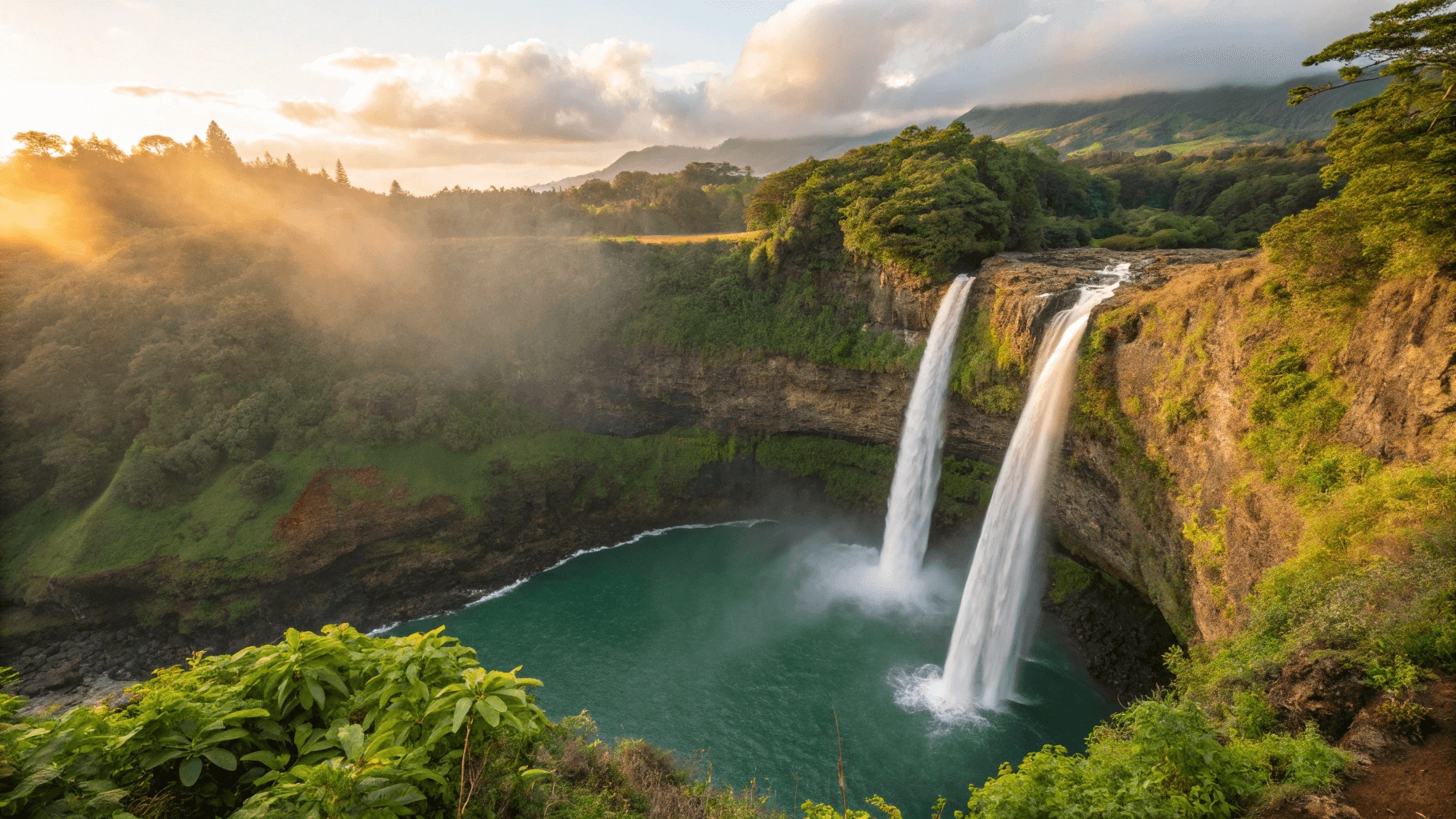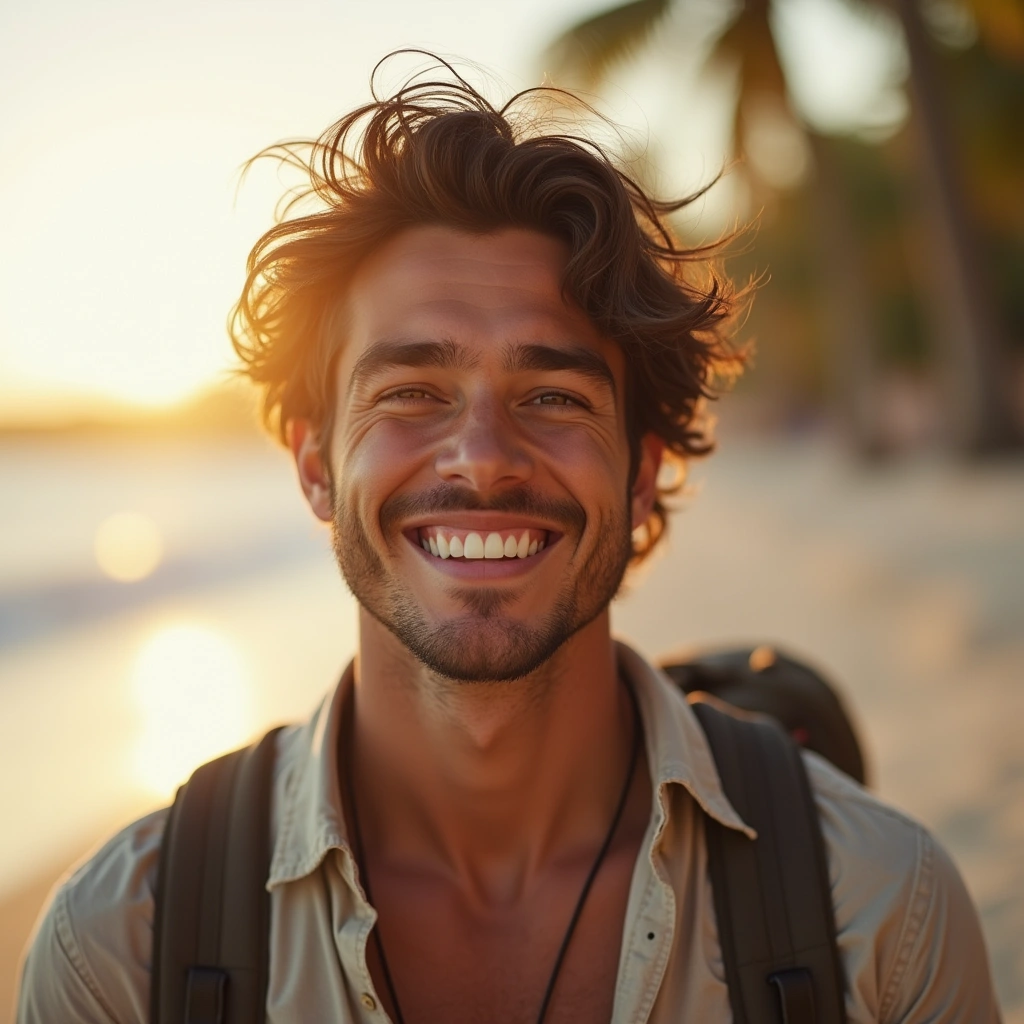Introduction
Welcome to paradise’s most accessible natural wonder. Wailua Falls stands as one of Kauai’s most iconic landmarks—a breathtaking twin waterfall cascading down lush, emerald cliffs into a serene pool below. Made famous by the opening credits of the classic TV show “Fantasy Island,” these majestic falls offer one of the most rewarding experiences on the Garden Isle with virtually no effort required.
Unlike many of Kauai’s natural treasures that demand challenging hikes or boat trips, Wailua Falls delivers spectacular beauty just steps from your car. This 80-173 foot double cascade creates an unforgettable sight that captures the essence of Hawaii’s tropical splendor in one frame-worthy view.
Based on extensive research and local insights, this comprehensive guide provides everything you need to know about visiting Wailua Falls—from precise directions and parking tips to the best viewing times, photography advice, cultural significance, and crucial safety information. Whether you’re planning your first trip to Kauai or you’re a returning visitor looking to experience this natural wonder properly, this guide ensures you’ll make the most of your visit to one of Hawaii’s most photographed waterfalls.
Table of Contents
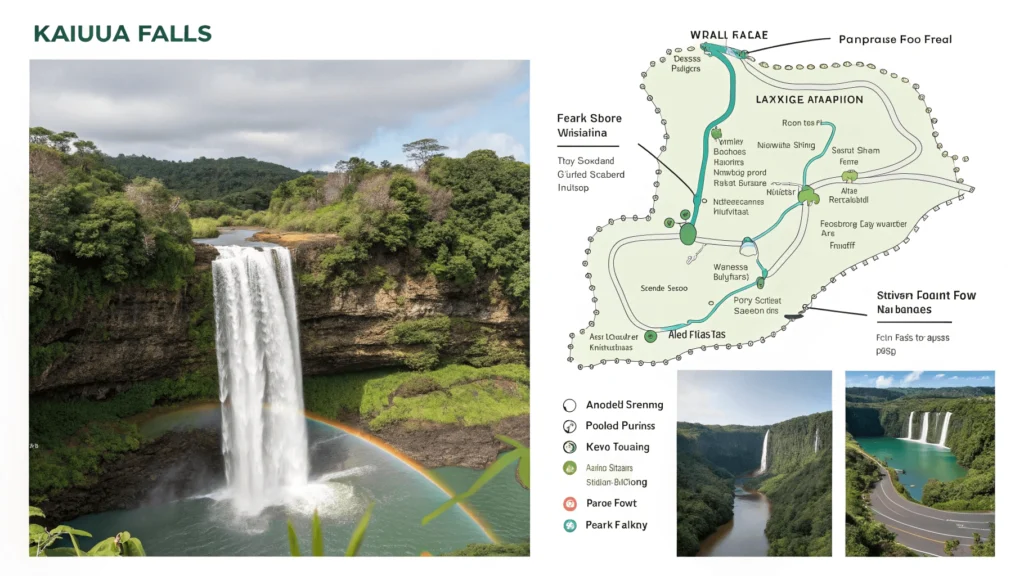
Quick Facts & Key Information
| Feature | Details |
|---|---|
| Location | Lihue District, Kauai, Hawaii |
| GPS Coordinates | 22.0361° N, 159.3783° W |
| Height | ~80-173 feet (measurements vary depending on source) |
| Accessibility | Roadside viewpoint, easily accessible |
| Hiking | STRICTLY PROHIBITED and dangerous (enforced by DLNR) |
| Best Time to Visit | Morning (for rainbows), after rainfall (for fuller flow) |
| Cost | Free |
| Parking | Limited roadside parking |
| Facilities | None at viewpoint |
| Difficulty | Very easy (viewable from parking area) |
| Time Needed | 15-30 minutes |
Why Visit Wailua Falls? The Experience
A Visual Masterpiece
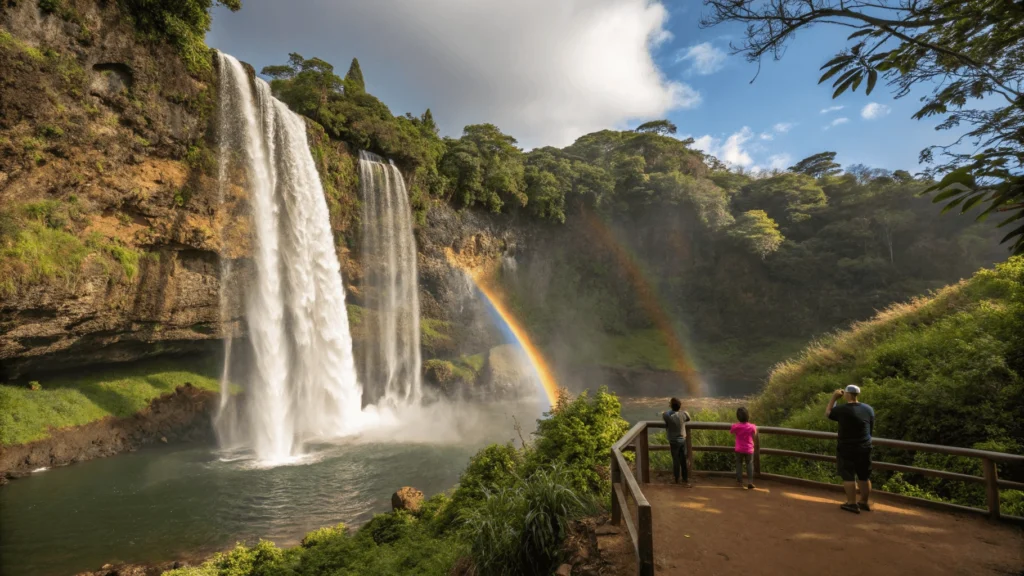
Wailua Falls presents a scene that seems crafted specifically for postcards and social media feeds. The twin cascades—sometimes merging into one powerful flow during heavy rains—plunge dramatically over ancient volcanic rock into a deep, emerald pool below. Surrounded by lush tropical vegetation that clings to vertical cliff faces, the falls create a perfect harmony of water, stone, and greenery that epitomizes Hawaii’s natural beauty.
On sunny mornings, the mist from the falls catches the light to form vibrant rainbows that arch across the gorge—a phenomenon that has made this spot particularly beloved by photographers and romantic souls alike. The thundering sound of water combined with the visual spectacle creates a multisensory experience that stays with visitors long after they’ve left the island.
Unmatched Accessibility
What truly sets Wailua Falls apart from many of Kauai’s natural wonders is its remarkable accessibility. While some of Hawaii’s most beautiful waterfalls require strenuous hikes through muddy terrain or expensive boat tours, Wailua Falls offers its splendor just steps from the roadside viewpoint. This ease of access makes it perfect for:
- Families with young children or elderly members
- Visitors with limited mobility
- Travelers with tight schedules
- Those seeking a quick but memorable photo opportunity
- Anyone wanting to experience Kauai’s natural beauty without a challenging trek
Cultural Significance
Beyond its visual appeal, Wailua Falls holds deep cultural significance for native Hawaiians. The falls are located within the broader Wailua River Valley—an area once reserved exclusively for Hawaiian royalty (ali’i) and considered one of the most sacred regions on the island. The name “Wailua” itself translates to “two waters,” referencing either the twin falls or the two branches of the Wailua River.
The Fantasy Island Legacy
For television enthusiasts, Wailua Falls holds additional allure as the waterfall featured in the opening credits of the popular 1970s-80s show “Fantasy Island.” This pop culture connection has drawn visitors for decades, cementing the falls as not just a natural wonder but a piece of entertainment history as well.
Getting There & Parking
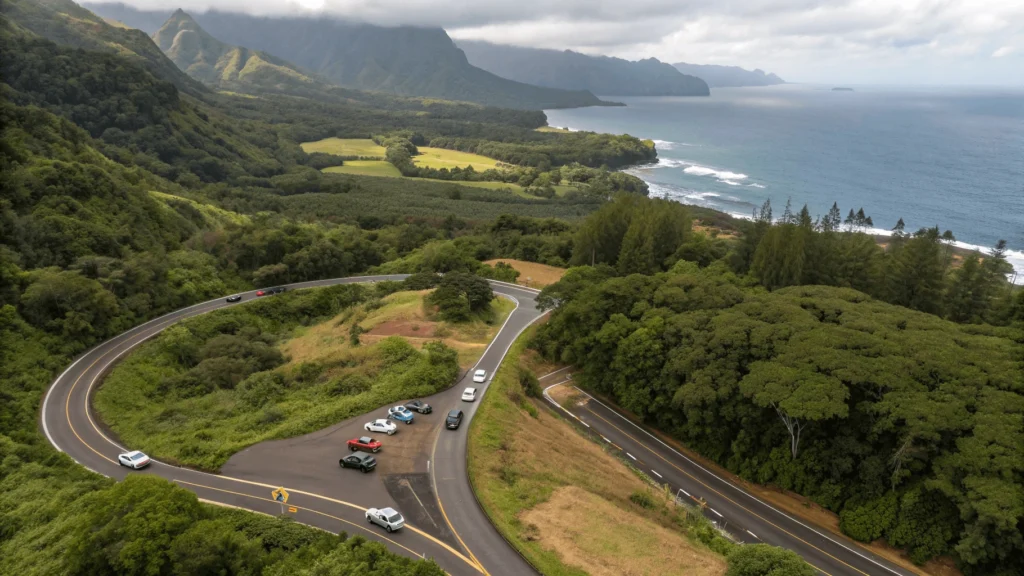
Detailed Driving Directions
Finding Wailua Falls is relatively straightforward, but a few key details will ensure you don’t miss this magnificent sight.
From Lihue Airport/Town:
- Head north on Highway 56 (Kuhio Highway)
- After approximately 2.5 miles, turn right onto Ma’alo Road (Highway 583)
- Follow Ma’alo Road for about 3 miles until it dead-ends at the falls viewpoint
- Total driving time from Lihue: approximately 15-20 minutes
From North Shore (Princeville/Hanalei):
- Drive south on Highway 56 (Kuhio Highway)
- Continue through Kapaa and Wailua
- Approximately 3 miles after crossing the Wailua River Bridge, turn left onto Ma’alo Road (Highway 583)
- Follow Ma’alo Road for about 3 miles until it ends at the falls viewpoint
- Total driving time from Princeville: approximately 45-50 minutes
From South Shore (Poipu/Koloa):
- Take Maluhia Road (Highway 520) to connect to Highway 50
- Follow Highway 50 to Lihue
- In Lihue, connect to Highway 56 North (Kuhio Highway)
- After approximately 2.5 miles, turn right onto Ma’alo Road (Highway 583)
- Follow Ma’alo Road for about 3 miles until it ends at the falls viewpoint
- Total driving time from Poipu: approximately 30-35 minutes
Local Tip: Ma’alo Road is a winding country road that passes through scenic farmland. The road narrows as you approach the falls, and the final approach includes several curves. Drive cautiously, especially if it’s raining, as the road can become slippery.
Parking Situation
The parking situation at Wailua Falls is limited and informal, which can be challenging during peak visiting hours:
- Capacity: Space for approximately 15-20 vehicles in the small roadside area
- Type: Unpaved shoulder/clearing at the end of Ma’alo Road
- Peak Times: Typically most crowded between 10 AM and 2 PM
- Alternatives: None nearby—if the area is full, you may need to wait for a spot or return later
Parking Tips:
- Arrive early (before 9 AM) or later in the afternoon (after 3 PM) to avoid crowds
- Be considerate of other visitors by parking efficiently
- Ensure your vehicle is completely off the road and not blocking traffic
- Don’t block the turnaround area at the end of the road
- Never park in front of local residential driveways
- Lock your vehicle and don’t leave valuables visible
Viewing the Falls: Best Spots & Times
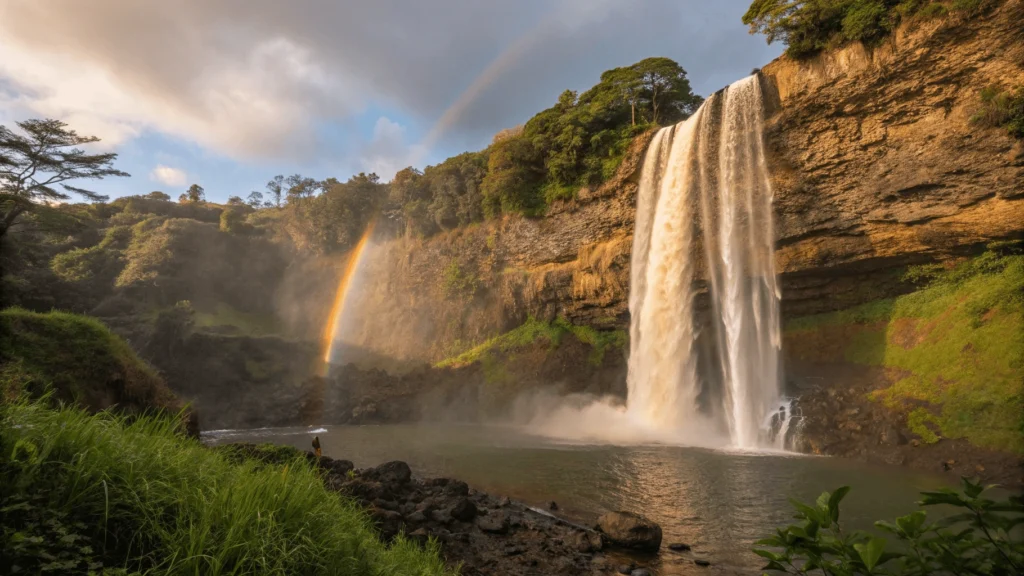
Main Viewpoint Experience
The primary viewing area for Wailua Falls is located right at the end of Ma’alo Road, where a low stone wall separates visitors from the steep drop-off to the gorge below. This vantage point offers a direct, frontal view of both cascades from approximately 173 feet away across the gorge.
Accessibility Notes:
- The main viewpoint is wheelchair accessible with assistance
- The area around the viewpoint is paved/graveled and mostly level
- Those with limited mobility can view the falls from their vehicle, though the best views require stepping out
- The viewing area is compact, measuring approximately 50 feet wide
Optimal Viewing Times
When you visit can dramatically impact your Wailua Falls experience:
Time of Day:
- Early Morning (7-9 AM): Often considered the prime time to visit for several reasons:
- Morning sun creates rainbows in the mist
- Typically less crowded
- Better lighting for photography
- Often clearer weather before afternoon clouds build
- Midday (10 AM-2 PM): Busiest time with tour groups; sun position can create harsh lighting and shadows
- Late Afternoon (3-5 PM): Fewer visitors; softer light but no rainbows; potential for afternoon rain
Weather Conditions:
- After Rainfall: The falls are at their most dramatic after heavy rain, transforming from twin cascades into a single, thundering curtain of water
- Sunny Mornings: Ideal for rainbow sightings in the mist
- Overcast Days: Provide even lighting for photography but reduce the chance of rainbows
Seasonal Consideration: Kauai’s east side receives more rainfall during winter months (November-March), potentially making the falls more powerful but also increasing the likelihood of foggy or rainy viewing conditions.
Photography Tips for Wailua Falls
Capturing the majesty of Wailua Falls requires some technical know-how to overcome the challenges of the location:
Equipment Recommendations:
- Wide-angle lens (16-35mm equivalent) to capture the entire scene
- Polarizing filter to reduce glare on water and enhance colors
- Neutral density filter for long exposures that smooth the water
- Tripod for stability during longer exposures
- Lens cloth (the mist can quickly fog lenses)
Camera Settings:
- For smooth, silky water: Use a slower shutter speed (1/15 sec or slower)
- For freezing droplets: Fast shutter speed (1/500 sec or faster)
- Bracket exposures to handle the high contrast between bright water and darker vegetation
- Consider HDR techniques for balanced exposures
Composition Tips:
- Include the surrounding landscape for context
- Try vertical compositions to emphasize the height of the falls
- Use the natural framing of the gorge to direct attention
- Include people (from a safe distance) to provide scale
- Experiment with different zoom levels to capture both wide vistas and details
Pro Tip: Morning visits often provide the best natural lighting, with the sun positioned behind you illuminating the falls. Between 7-9 AM, look for rainbows in the mist—position yourself so the sun is at your back for the best chance of capturing this magical effect.
CRITICAL: Safety & Regulations
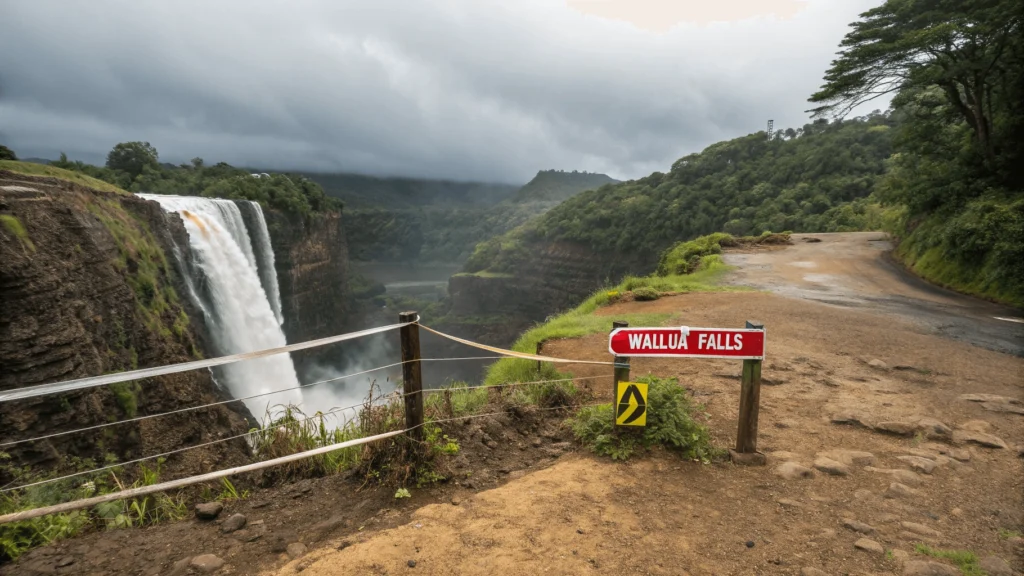
DO NOT Hike Down to Wailua Falls: Official Warnings & Dangers
Despite what you might read in outdated guidebooks or unofficial websites, hiking to the base of Wailua Falls is STRICTLY PROHIBITED, dangerous, and illegal. The Department of Land and Natural Resources (DLNR) actively enforces this prohibition for several critical reasons:
Official Position: According to the Hawaii Department of Land and Natural Resources, the trail to the base of Wailua Falls is closed to the public. Attempting to access the base of the falls violates state regulations and can result in fines.
Severe Dangers Include:
- Extremely Steep, Unstable Terrain: The informal “trail” features near-vertical sections with loose soil and rocks
- Slippery Conditions: Even in dry weather, the path is treacherous; when wet, it becomes virtually impossible to navigate safely
- Flash Flood Risk: Sudden rainfall upstream can cause rapid water level increases without warning
- Rescue Difficulties: Emergency personnel face significant challenges and dangers when attempting rescues
- Hidden Underwater Hazards: Submerged rocks, strong currents, and fluctuating depths in the pool
Past Incidents: Numerous serious injuries and fatalities have occurred at Wailua Falls over the years. Local emergency services regularly conduct difficult and dangerous rescues of visitors who ignore warnings and get into trouble.
Official Statement: The Hawaii DLNR states: “The trail to Wailua Falls is not maintained and is extremely dangerous. Several people have died or been seriously injured attempting to reach the pool below. Access is strictly prohibited.”
Respect the ‘Āina (Land)
Beyond personal safety, respecting the regulations at Wailua Falls is a matter of cultural respect and environmental preservation:
- The area holds cultural significance for Native Hawaiians
- Unauthorized trails cause erosion and damage to native plant life
- Wildlife habitats can be disrupted by off-trail exploration
- The peaceful atmosphere of this sacred place is diminished by reckless behavior
Show your respect by:
- Enjoying the falls from the designated viewing areas only
- Following all posted rules and regulations
- Packing out all trash
- Speaking quietly and being mindful of other visitors
- Not attempting to access restricted areas
History, Legends & Cultural Significance
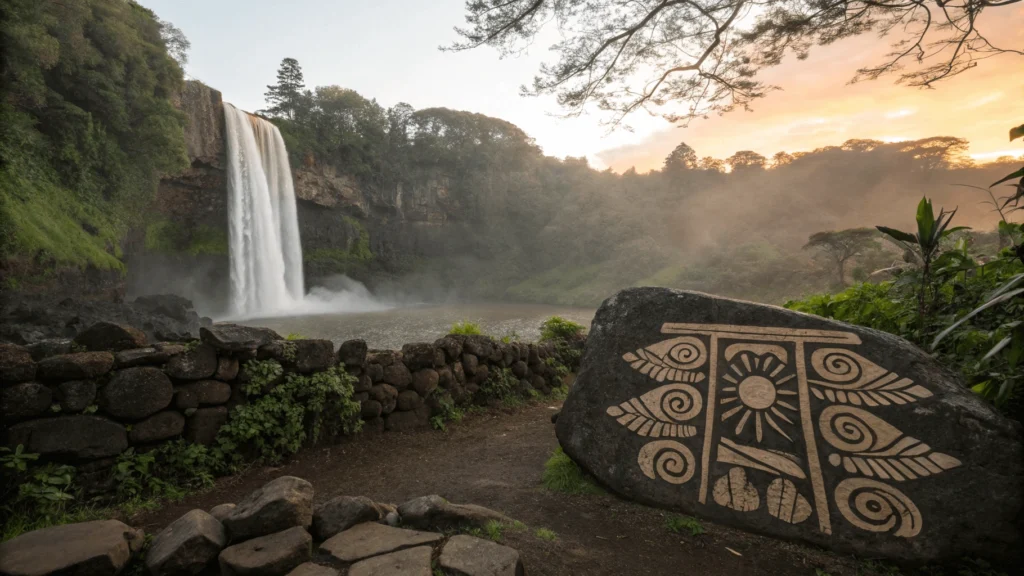
Ancient Hawaiian Connections
The Wailua River Valley, where the falls are located, was one of the most sacred areas in ancient Hawaii. This region was kapu (forbidden) to all but the highest-ranking ali’i (royalty) and kahuna (priests). The entire Wailua area was considered a puʻuhonua (place of refuge) and home to numerous heiau (temples) that still exist today.
Wailua Falls itself features prominently in Hawaiian mo’olelo (legends). According to some accounts, the pool below the falls was used by ali’i for ritual bathing. The name “Wailua” translates to “two waters,” which may reference either the twin falls themselves or the two forks of the Wailua River, Hawaii’s only navigable river.
The Leaping Place Legend
One of the most persistent legends surrounding Wailua Falls involves its purported use as a test of courage for young Hawaiian warriors. According to this mo’olelo, young men would prove their bravery by leaping from the top of the falls into the pool below. Those who survived were considered to have the favor of the gods and worthy of warrior status.
Historical Note: While this legend is frequently repeated, some Hawaiian cultural experts question its authenticity, noting that such practices would have been inconsistent with the kapu nature of the Wailua area. The story may have been embellished or created during the early tourism era.
Modern Fame: The Fantasy Island Connection
Wailua Falls gained international recognition in the 1970s and 1980s when it was featured prominently in the opening credits of the popular television series “Fantasy Island.” As the show’s distinctive small plane flew over the falls in each episode, millions of viewers worldwide were introduced to this natural wonder, cementing its place as one of Kauai’s must-see attractions.
This pop culture connection significantly boosted tourism to the falls and remains a point of interest for visitors of a certain generation. The iconic introduction with Ricardo Montalbán announcing “The plane! The plane!” while Wailua Falls filled television screens helped transform this once-remote spot into a tourism hotspot.
Wailua Falls in Context: Wailua River State Park & Nearby Attractions
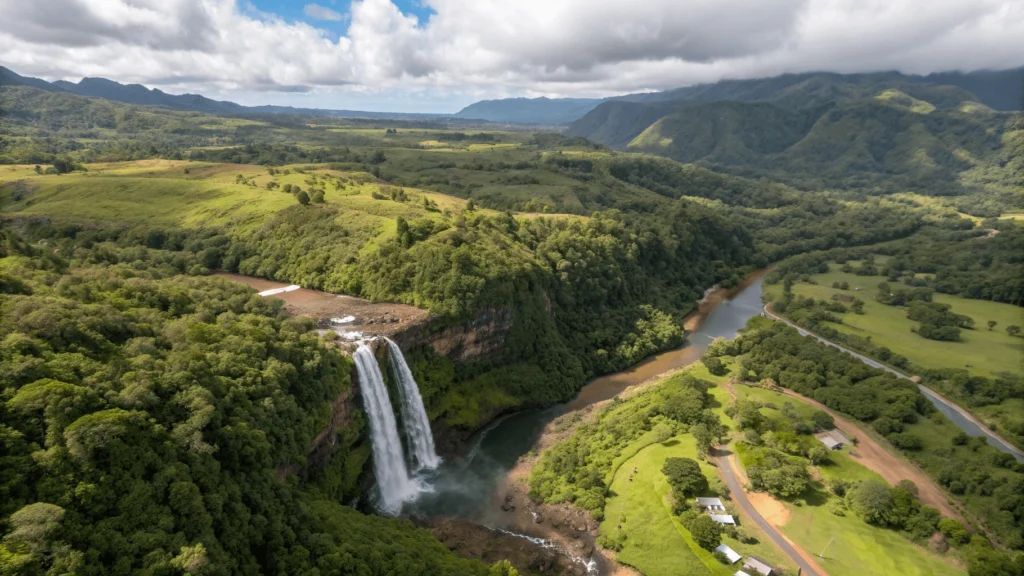
Wailua River State Park Overview
Wailua Falls is one of the crown jewels of the broader Wailua River State Park, which encompasses numerous historically and culturally significant sites along Hawaii’s only navigable river. This area represents one of the most important archaeological regions in the Hawaiian Islands, with structures dating back many centuries.
Key Features of Wailua River State Park:
- Hawaii’s only navigable river
- Ancient heiau (temples) including Holoholokū Heiau and Hikina-a-ka-lā Heiau
- The “Royal Birthstones” where ali’i (royalty) gave birth
- Petroglyphs representing ancient Hawaiian culture
- Lush rainforest and diverse ecosystems
Nearby Attractions Worth Combining With Your Visit
To maximize your exploration of the area, consider combining your visit to Wailua Falls with these nearby attractions:
1. Opaeka’a Falls (15 minutes from Wailua Falls)
Another easily accessible waterfall viewpoint offering a different but equally impressive cascade. Located off Kuamoo Road (Highway 580), Opaeka’a Falls provides a convenient comparison to Wailua Falls—both beautiful but distinctly different in character.
2. Wailua River Boat Tours (20 minutes from Wailua Falls)
Companies like Smith’s Tropical Paradise offer guided boat tours up the Wailua River to the Fern Grotto, a lava rock grotto draped with hanging ferns. These tours often include cultural performances and botanical information.
3. Kamokila Hawaiian Village (20 minutes from Wailua Falls)
A reconstructed ancient Hawaiian village offering insights into traditional Hawaiian life, crafts, and cultural practices. Located along the Wailua River, this educational attraction provides historical context for the entire region.
4. Poliahu Heiau (15 minutes from Wailua Falls)
An ancient temple site accessible via a short walk from Kuamoo Road. This partially restored heiau offers a glimpse into ancient Hawaiian religious practices and architecture.
5. Lydgate Beach Park (25 minutes from Wailua Falls)
A family-friendly beach with protected swimming areas, perfect for cooling off after your waterfall visits. Features include picnic facilities, playgrounds, and walking paths.
Suggested Itinerary: A full “East Side Waterfall Tour” could include morning views of Wailua Falls (with rainbows), followed by Opaeka’a Falls, lunch at Kapaa town, and an afternoon Wailua River boat tour or visit to Kamokila Hawaiian Village.
Comparing Wailua Falls to Other Kauai Waterfalls
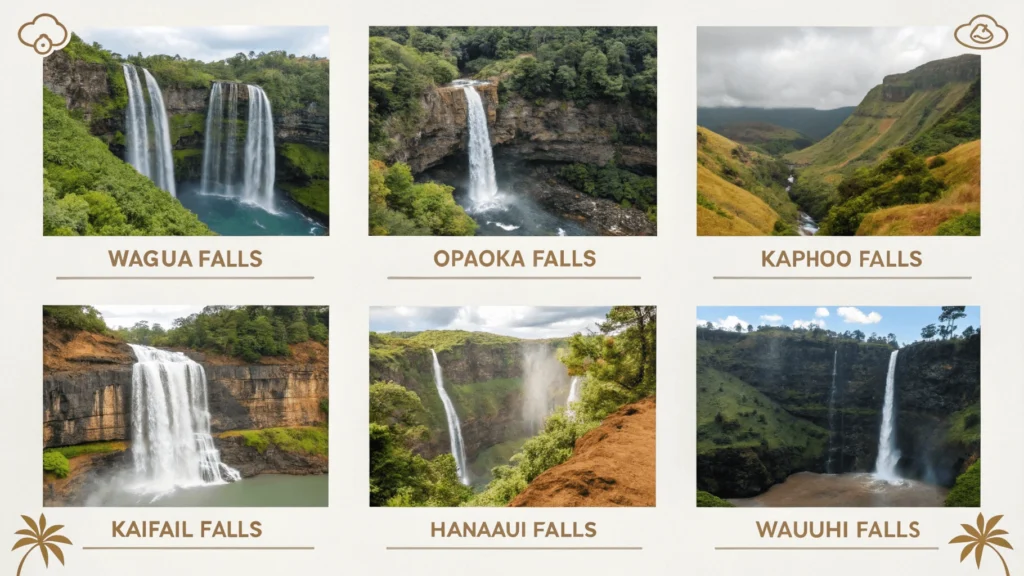
Kauai is known as the “Garden Isle” partly due to its abundant rainfall creating numerous spectacular waterfalls. Here’s how Wailua Falls compares to other notable cascades on the island:
| Waterfall | Height | Accessibility | Effort Required | Unique Features |
|---|---|---|---|---|
| Wailua Falls | 80-173 ft | Very Easy | None (roadside) | Twin falls, rainbow potential, “Fantasy Island” fame |
| Opaeka’a Falls | 151 ft | Very Easy | None (roadside) | Wide single cascade, consistent flow year-round |
| Waipo’o Falls | 800 ft | Moderate | 3-4 mile hike | Dramatic height, Waimea Canyon views |
| Hanakapiai Falls | 300+ ft | Difficult | 8-mile round trip hike | Remote, pristine setting on Na Pali Coast |
| Manawaiopuna Falls | 400 ft | Very Difficult | Helicopter only | “Jurassic Park” falls, limited accessibility |
| Uluwehi Falls (Secret Falls) | 100+ ft | Moderate | Kayak + hike | Secluded swimming hole, jungle setting |
What Makes Wailua Falls Special:
- Accessibility: No other major falls on Kauai offer such impressive views with zero hiking required
- Dramatic Drop: The sheer, unobstructed plunge creates a more dramatic visual than some taller falls
- Twin Cascades: The dual streams create a distinctive and photogenic pattern
- Morning Rainbows: Reliable rainbow formation (in proper conditions) is relatively rare
- Cultural Significance: Deep connection to native Hawaiian history and legends
Visitor Perspective: “While Hanakapiai Falls might be more rewarding for hikers and Manawaiopuna more exclusive, Wailua Falls offers the best ‘reward-to-effort ratio’ of any waterfall on Kauai. The ease of access combined with its impressive beauty makes it a must-see, especially for those with limited time or mobility.”
Practical Visitor Tips & Etiquette
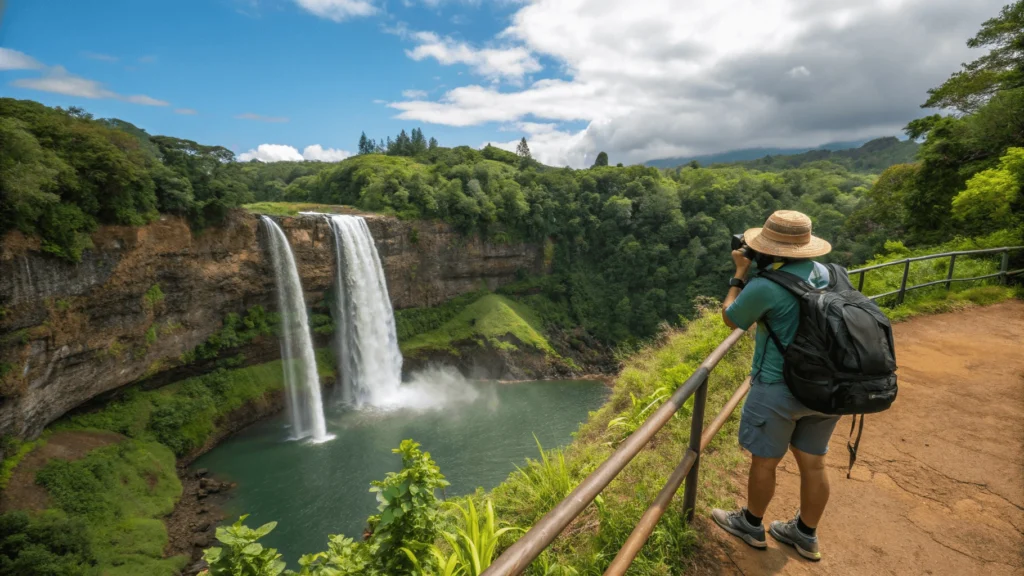
Timing Your Visit
Seasonal Considerations:
- April-October (Dry Season): More consistent viewing conditions but potentially less dramatic water flow
- November-March (Wet Season): More vibrant falls due to increased rainfall, but higher chance of foggy conditions
- Weekday mornings: Generally the least crowded time to visit
- Cruise ship days: Can be extremely busy when ships are docked in Nawiliwili Harbor (check cruise schedules online)
What to Bring
Essentials for Enjoying Wailua Falls:
- Camera or smartphone (fully charged)
- Sun protection (hat, sunscreen, sunglasses)
- Light rain jacket or poncho (weather can change quickly)
- Water bottle (no facilities on site)
- Binoculars for spotting details and wildlife
- Small cash for potential local vendors occasionally in the parking area
What NOT to Bring:
- Drones (illegal in state parks without permits)
- Hiking gear (to avoid temptation of prohibited trails)
- Alcohol (prohibited in public areas)
Time Allocation
Most visitors spend between 15-30 minutes at the falls viewpoint. This provides ample time to:
- Appreciate the falls from different angles within the viewing area
- Take photographs in varying compositions
- Listen to the powerful sound of cascading water
- Look for rainbows in the mist (morning visits)
- Read informational signs about the area
Suggestion: Rather than rushing through a quick photo stop, consider spending a quiet 15 minutes simply absorbing the natural beauty. The peaceful atmosphere and negative ions from the falls can be remarkably rejuvenating.
Visitor Etiquette
Being a respectful visitor not only preserves the experience for others but honors the cultural significance of this special place:
Do:
- Keep voices low, allowing others to enjoy the natural sounds
- Take turns at prime viewing spots for photos
- Pack out everything you bring in (no trash cans on site)
- Respect the barriers and stay within designated viewing areas
- Be patient and courteous when parking is limited
Don’t:
- Fly drones (illegal without permits)
- Play loud music
- Leave trash behind
- Attempt to access closed areas
- Block the view for extended periods during busy times
- Disturb wildlife or vegetation
Special Note on Local Community Relations
The road to Wailua Falls passes through residential areas and farm properties. Respect for local communities is emphasized in Hawaii tourism guidelines published by the Hawai‘i Tourism Authority. Showing respect for local residents helps maintain positive relationships between visitors and the community:
- Drive slowly through residential sections
- Don’t block private driveways
- Keep noise to a minimum, especially in early morning or evening hours
- Support local vendors when possible
- Be mindful that this is a community, not just a tourist destination
Frequently Asked Questions About Wailua Falls
Can you swim at Wailua Falls?
No, swimming at Wailua Falls is strictly prohibited. Access to the pool below the falls is illegal, extremely dangerous, and actively enforced by local authorities. The risks include slippery rocks, strong currents, flash flood danger, and difficult rescue conditions.
Can you hike to the bottom of Wailua Falls?
No, hiking to the bottom of Wailua Falls is illegal, dangerous, and prohibited by the Hawaii Department of Land and Natural Resources (DLNR). The unofficial trail is extremely steep, slippery, and has been the site of numerous injuries and fatalities.
How tall is Wailua Falls?
Wailua Falls is approximately 80-173 feet tall, depending on the measurement method and source. The discrepancy exists because different measurements may include or exclude portions of the cascades above the main drop.
Is Wailua Falls easy to get to?
Yes, Wailua Falls is one of the most accessible major waterfalls in Hawaii. It can be viewed from a roadside lookout at the end of Ma’alo Road (Highway 583), requiring no hiking and only about 15-20 minutes of driving from Lihue.
Is Wailua Falls free to visit?
Yes, visiting Wailua Falls is completely free. There are no entrance fees, parking fees, or other costs associated with viewing the falls from the public lookout.
When is the best time to see a rainbow at Wailua Falls?
The best time to see rainbows at Wailua Falls is typically between 7-10 AM on sunny mornings. The sun’s position during these hours creates optimal conditions for rainbow formation in the mist, especially when viewed from the main lookout point.
Was Wailua Falls really in Fantasy Island?
Yes, Wailua Falls was featured prominently in the opening credits of the popular television series “Fantasy Island,” which aired from 1977 to 1984. The falls appeared as the small plane carrying guests flew over them in each episode’s introduction.
Is Wailua Falls worth visiting?
Absolutely! Wailua Falls offers one of the best effort-to-reward ratios of any attraction on Kauai. Its spectacular twin cascades, easy accessibility, cultural significance, and potential for rainbow sightings make it a worthwhile stop for virtually any visitor to the island.
How much time should I spend at Wailua Falls?
Most visitors spend 15-30 minutes at the falls, which is generally sufficient for taking photos and enjoying the view. However, those interested in photography, especially catching rainbows in the morning light, might want to allow up to an hour.
Are there restrooms at Wailua Falls?
No, there are no restroom facilities at the Wailua Falls viewpoint. The nearest public restrooms are located in Lihue town, approximately 10-15 minutes away by car.
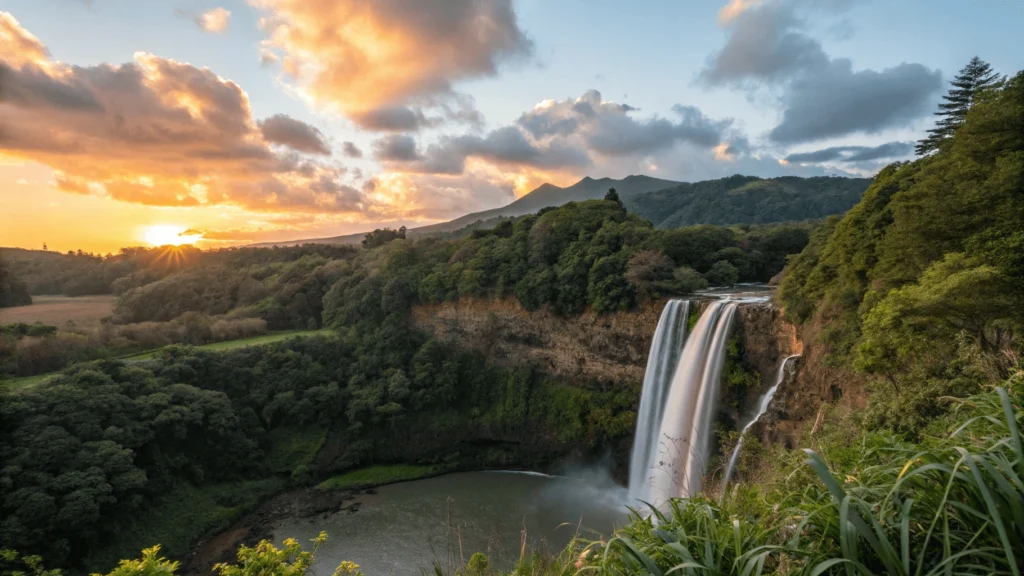
Conclusion
Wailua Falls stands as a testament to the accessible natural beauty that makes Kauai such a beloved destination. With its dramatic twin cascades, rich cultural history, and exceptional accessibility, it deserves its reputation as one of the island’s must-see attractions.
What makes this natural wonder truly special is how it combines breathtaking beauty with unparalleled convenience—offering a genuine slice of paradise without requiring significant time, effort, or expert planning. In a world where many natural wonders demand challenging journeys, Wailua Falls reminds us that sometimes nature’s most spectacular displays are hiding just around the corner.
As you plan your Kauai itinerary, make sure to include this iconic landmark, preferably in the rainbow-kissed morning hours. Respect the cultural significance of the area, adhere to safety guidelines, and take a moment to simply be present with one of Hawaii’s most photographed and beloved natural treasures.
Whether you’re a first-time visitor to the Garden Isle or a returning traveler seeking to experience every facet of Kauai, Wailua Falls offers a perfect combination of natural splendor, cultural significance, and practical accessibility that exemplifies the magic of Hawaii.
Mahalo for reading our comprehensive guide to Wailua Falls. Safe travels and aloha!

